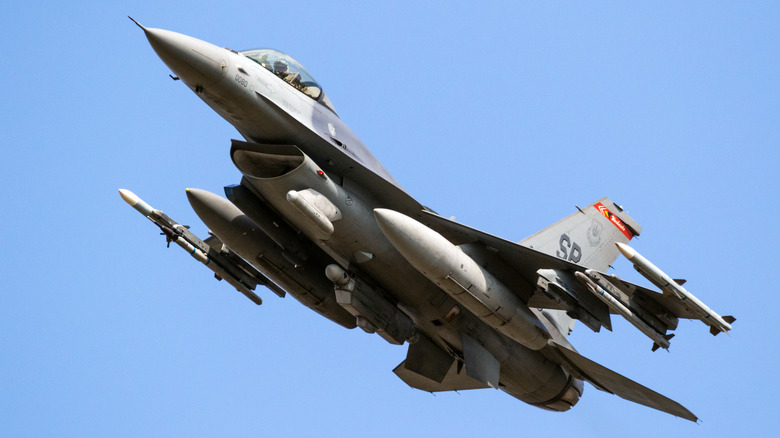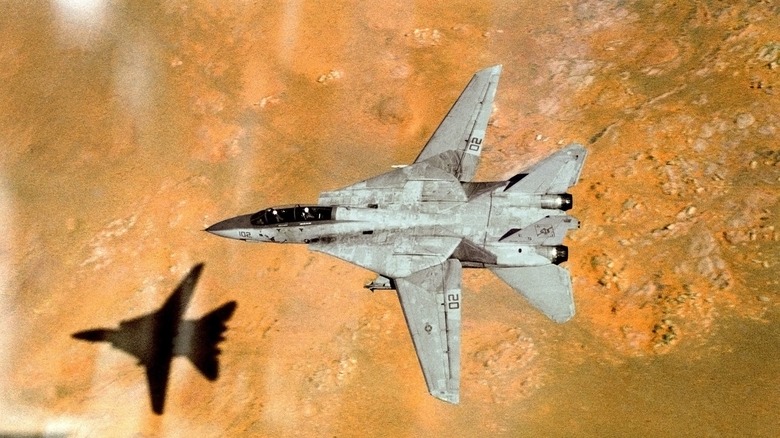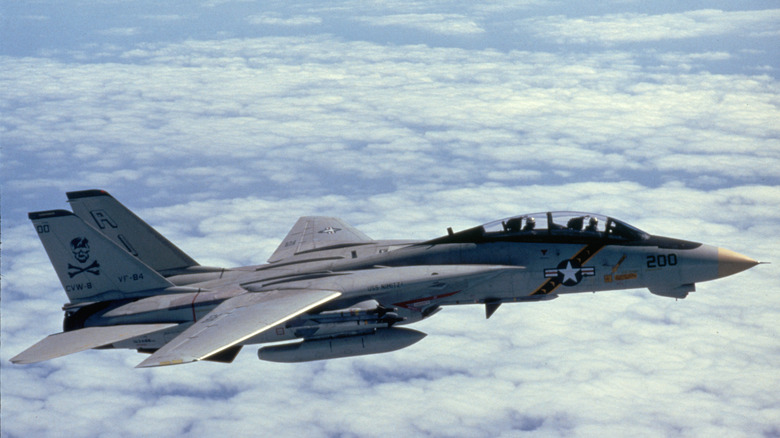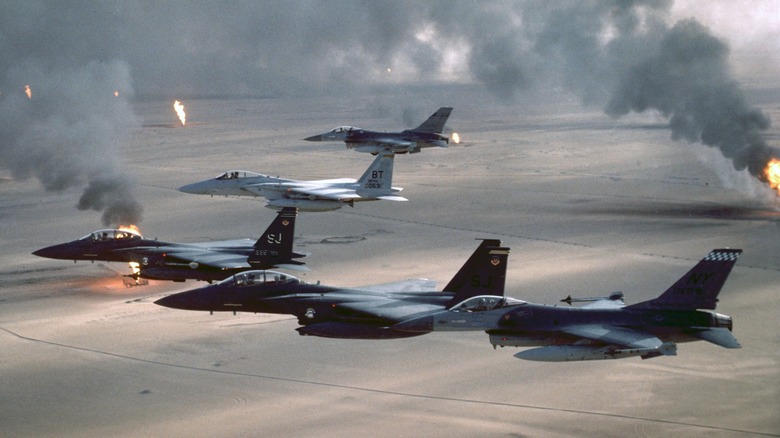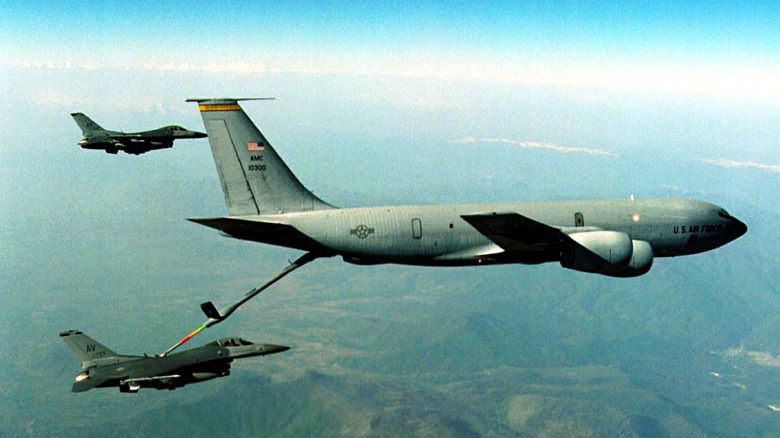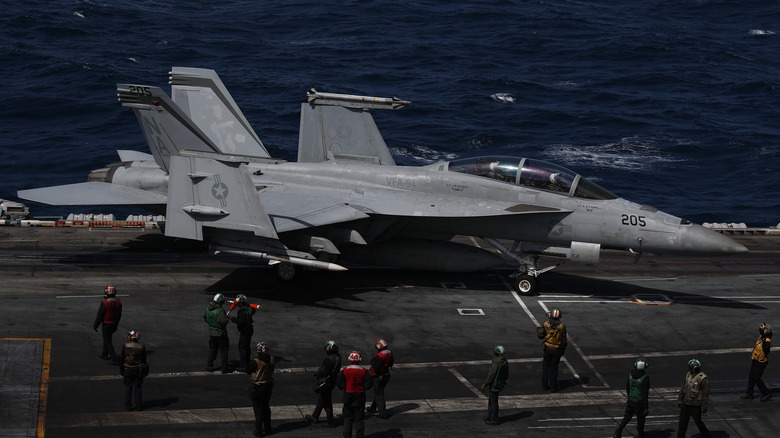Every United States Air Victory From Vietnam To Today
Over the course of World War II, combat aircraft flown by the United States, either with the United States Army Air Corps or U.S. Navy, accomplished tens of thousands of air combat victories or kills and successfully shot down a manned enemy aircraft. Just the F-6F Hellcat, a single variety of planes, is accredited with destroying 5,156 enemy planes in the Pacific Theater. Over in Europe, the legendary P-51 Mustang alone scored 4,950 air victories.
Over the skies of Korea, as fighter jets became the norm, the United States Air Force's F-86 Sabre shot down nearly 800 Chinese and North Korean aircraft. During the Vietnam War, heat-seeking missiles like the AIM-9 "Sidewinder" instead of machine guns became the weapon of choice for aviators, and air-to-air combat numbers dropped dramatically. Over the course of the war, U.S. Forces downed 137 Soviet-designed MiGs, with variations of the F-4 Phantom taking the lion's share at 107 victories.
Modern air combat is infrequent
In the 50 years since the United States pulled out of Vietnam, the number of air combat victories against manned aircraft has plummeted. Once you break down the types of conflicts the United States has been involved with, it starts to make more sense why air combat isn't as prevalent. Even when, seemingly, the number of armed conflicts happening at any given time doesn't seem to diminish. In World War II, the Korean War, and the War in Vietnam, the United States and its allies were fighting against the air power of an entire country (i.e., Imperial Japan, Nazi Germany, North Korea, and North Vietnam). Aside from Desert Storm, recent conflicts have involved non-state actors (ISIS or Al-Qaeda) or smaller forces without much in the way of air power (U.S. Invasion of Panama). Plus, the introduction of drones (or Chinese surveillance balloons) into the modern battlefield has cut down on overall manned air combat.
The United States has the most technologically advanced fleet of aircraft in the world today, and very few of those jets have seen any sort of combat. However, when the rare times in recent history when a U.S. pilot has needed to fire its weapons in anger, it has nearly always come out on top.
The Gulf of Sidra Incidents
During training exercises in 1981 in the Gulf of Sidra off the coast of Libya, a pair of F-14 Tomcat carrier-based air superiority fighters were fired upon by two Libyan Sukhoi Su-22 fighter bombers who believed the Tomcats were encroaching upon Libyan air space. The pilot in one of the Tomcats evaded the Sukhoi-fired missile and returned the gesture with an AIM-9 Sidewinder, splashing one of the Sukhois. Another missile knocked the second Su-22 out of the sky. According to the United States Naval Institute, the entire air-to-air battle lasted less than 60 seconds.
In 1989, another pair of F-14 Tomcats were engaged in a fight near the Gulf of Sidra. In this instance, two Libyan MiG-23 Flogger fighters fired on the U.S. Navy Tomcats and were quickly outmatched, getting shot down by two well-placed Sidewinder missiles. Both MiG-23 pilots were reported to have ejected from their aircraft before the plane went down. Those two incidents mark the first four air victories of the F-14 Tomcat.
Air combat in the Gulf War and Iraqi no fly zones
As the United States and Coalition Forces entered into the first Gulf War in 1991, air combat ramped up considerably as it was the first time that many modern aircraft like the F-15 Eagle and F-18 Hornet had ever seen combat of any kind. Saddam Hussein's air power was comprised of several Soviet-built Sukhoi and MiG fighters as well as the French-manufactured Dassault F-1 Mirage. Additionally, Iraqi forces utilized many Soviet helicopters.
The vast majority of the United States' 41 air kills during the Gulf War were by the F-15, using a mixture of AIM-7 and AIM-9 air-to-air missiles. Additionally, enforcement of no-fly zones after the conflict and leading into the 2003 Invasion of Iraq saw more than two more shootdowns, including the first air victory for an F-16 when it downed a MiG-23. The continued usage of air-to-air missiles showed a modern fighter plane's ability to nullify competing air power.
NATO operations in the 1990s
In 1993, NATO (North Atlantic Treaty Organization) used American air power to control the air space over Bosnia and Herzegovina. In 1994, four Serbian J-21 Jastreb fighter bombers were shot down after performing a bombing raid on Bosnian targets. United States Air Force F-16s used AIM-9 heat-seeking missiles and AIM-120 radar-guided missiles in the engagement. This battle marks the first time that NATO forces engaged in combat.
During NATO's bombing of targets in Yugoslavia, American pilots downed five Yugoslavian MiG-29 aircraft over the entire engagement. Notably, not a single NATO aircraft were lost by enemy air power. The AIM-120 radar-guided was praised during the conflict as it could hit a target even when the enemy aircraft was too far away to see. After NATO's involvement in Europe, air combat would die down for well over a decade, as enemy organizations the United States were fighting in the early 2000s and 2010s did not have regular air forces.
Recent years
That pause came to an end in 2017 during the still ongoing Syrian Civil War. In June, a Syrian Sukhoi Su-22 fighting for Bashar Al-Assad's forces attacked Syrian forces on the ground friendly to the United States. It was then engaged by an F/A-18 Super Hornet and brought down with air-to-air missiles. Since 2017, there have been no more known (or declassified) incidents of U.S. aircraft engaging other manned aircraft. Although combat against unmanned surveillance apparatuses and drones remains fairly common, with the most recent drone shootdown happened on October 5 when an F-16 downed a Turkish drone.
Although jets like the F-22 Raptor and F-35 Lightning II are the newest and shiniest members of the United States military's air power — older aircrafts like the F-15 Eagle (debuting in 1975) and the F-16 (which first came into the fold in 1979) have proved themselves the most capable air-to-air fighters in the armed forces.
